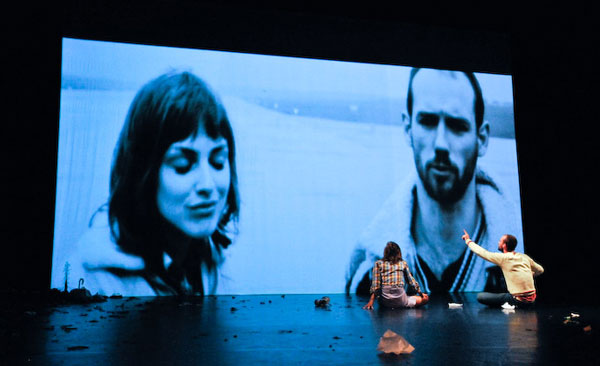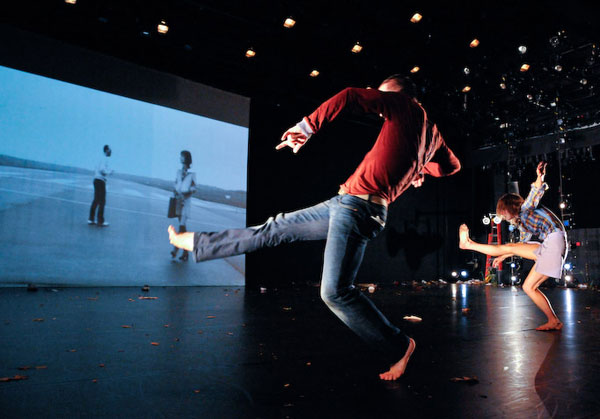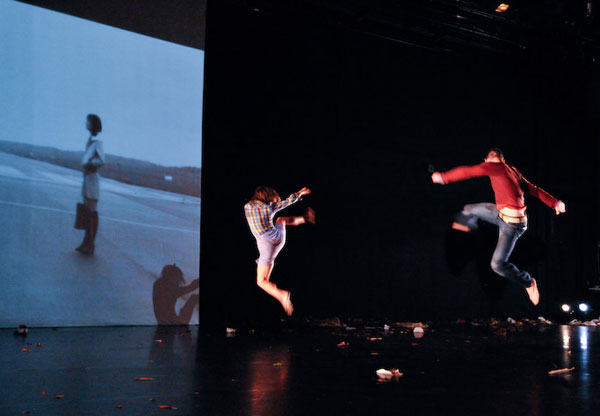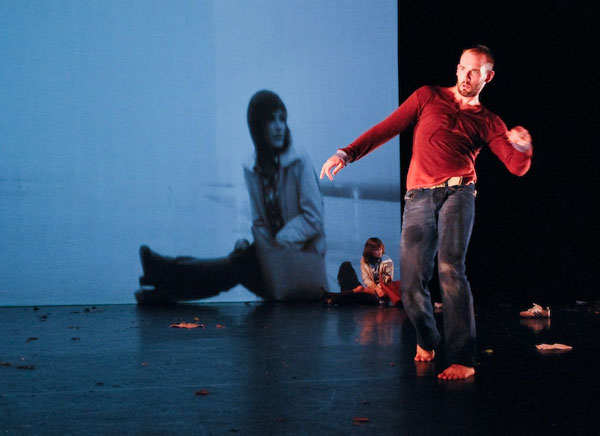



Barry and I went to Dance Theater Workshop [DTW] last night for a performance of "roadkill", a dance, text, video and music work choreographed by Johannes Wieland. The performers were Ryan Mason and Eva Mohn. They were doubled by their own moving images in the huge projection which dominated half of the far wall. It was a video by Wieland, who was also responsible for the text, the set and the costumes. The music was by Ben Frost.
The piece itself was phenomenal, even by the standards of DTW, and the performers were incredible.
Mohn is an extraordinary dancer and actor (and musician, and one of the most hauntingly beautiful women I've ever seen. Mason was no less beautiful, with an incredibly elegant athleticism. He seemed to be in almost constant motion, leaping and spinning in midair, frenetic but disciplined, much of the time dressed in some serious layers of clothing. We watched his body do things I had I would not have thought possible for a mere mortal. Barry said it almost seemed like they both could turn their waists 360 degrees.
The music perfectly matched the dance and the theater; Frost was clearly a full partner in the success of the work.
Don't miss it.
At the beginning of the performance, a young man and woman in ordinary street clothes are seen stranded on a barren airplane landing strip which is suggested on the stage by random weeds and paper debris. The two people, who appear à quatre, on a real runway through the magic of light, are alternately delighted and frightened by the sudden bizarre circumstances in which they have suddenly found themselves.
I experienced the piece largely as an abstraction, but its recurring and richly-drawn suggestions of narrative and purpose were probably as tantalizing for me and the rest of the audience as they were for the the fictive couples on the floor and on the screen. The press release offers this clue:
As foreigners in their own lives, they awaken with the touchdown of reality.
Delighted in their surreal circumstances, they watch the inevitable chaos of life unfold.
There is a "trailer" of sorts on the DTW site, but it's just a teaser; in this video of Mason in an excerpt from "Second Hand Luck", another piece choreographed by Wieland, the dancer does what YouTube label describes as his "underpants dance". It's over the top.
These are the "roadkill" performance details:
Performances are tonight, Friday, and Saturday at 8 p.m., Sunday at 5 p.m.
Tickets are $15; $12 for students
The location is Chelsea, 219 West 19th Street
(212) 924-0077
dancetheaterworkshop.org
While we waited for the lights to go down (Mohn and Mason were already hugging the masonry to the right of the screen, with their backs to the audience), I overheard a phrase spoken by someone sitting behind us, something to the effect of, "it's German, so it will be dark".
I'm going to step over the basis for that premise here (I'm referring to the common and unaccountably tenacious fallacy about the heaviness, even dismalness, of all things German), but not before I say that it describes a prejudice which I have never been able to share. Mostly because I am pretty familiar with things German, including both historic and contemporary Germanic culture, as well as the people who preserve it and continuously shape it anew, I know there is plenty of both the dark and the light, and everything between as well.
And by the way, "roadkill" isn't dark. Like all art, it asks only for involvement.
Wieland is a native German, although the dancers and much of the creative team are not. The most German part of the production and the company is probably the form of its patronage: Wieland is fully appreciated as an artist in his own country, and he's generously supported, by the state.
He originally established his company in New York, in 2002. He's gone on to amass a large resume with work in the U.S., but in 2007 he was appointed artistic director/choreographer for the resident theater company at the State Theater of Kassel, a town of less than 200,000 people in Hesse, a state with just over 6 million. There he has the full support of the local government, serving the culture at large. Because of this largesse he is able to undertake productions with 30 or more performers, with live musicians, and full orchestras, on all three stages of a modern destination theater.
Kassel, a modest town on the Fulda River, which for over 50 years has played host to Documenta, has an impressive record of support for theater and performance. The history of the State Theater began with the Ottoneum, built in 1604. It was the first purpose-built theater on the continent.
[images provided by the artist Sebastian Lemm]